
The Rimutaka Incline was a 3-mile-long (4.8 km), 3 ft 6 in gauge railway line on an average grade of 1-in-15 using the Fell system between Summit and Cross Creek stations on the Wairarapa side of the original Wairarapa Line in the Wairarapa district of New Zealand. The term "Rimutaka Incline" is sometimes used incorrectly to refer to other parts or all of the closed and deviated section of the Wairarapa Line between Upper Hutt and Speedy's Crossing, near Featherston. The incline formation is now part of the Remutaka Rail Trail.

The NZR RM class Model T Ford railcar was a type of rail motor that operated on New Zealand's national rail network. Only two were built, classified as RM 4 and RM 5, and they were experimental railcars designed in an attempt to offer improved passenger services on quiet country branch lines that served regions with small populations.
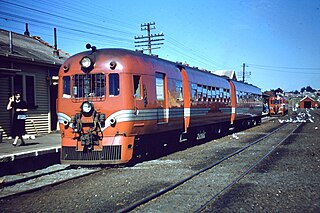
The NZR RM class 88-seaters were a class of railcar used in New Zealand. New Zealand Government Railways (NZR) classified them as RM (Rail Motor), the notation used for all railcars, numbering the 35 sets from RM100 to RM134. They were the most numerous railcars in NZR service. Their purchase and introduction saw the demise of steam-hauled provincial passenger trains and mixed trains, and was part of a deliberate effort to modernise NZR passenger services at a time of increasing competition from private motor vehicles. Being diesel powered and lighter the railcars were less expensive to operate and able to maintain quicker timetables, although became plagued with mechanical and electrical problems, with a number of the class eventually being turned into depowered locomotive-hauled carriages and reclassified as the AC class "Grassgrubs".

The Wairarapa Line is a secondary railway line in the south-east of the North Island of New Zealand. The line runs for 172 kilometres (107 mi), connects the capital city Wellington with the Palmerston North - Gisborne Line at Woodville, via Lower Hutt, Upper Hutt and Masterton.

The NZR RM class Wairarapa railcar was a class of railcars on New Zealand's national rail network. They entered service in 1936 and were classified RM like all other classes of railcars in New Zealand; they came to be known as the "Wairarapa" class as they were designed to operate over the famous Rimutaka Incline to the Wairarapa region on the Wairarapa Line. They also acquired the nickname of "tin hares" in New Zealand railfan jargon. The first two to be introduced re-used the numbers RM 4 and RM 5 that had previously been used by the withdrawn experimental Model T Ford railcars. The class consisted of six passenger railcars and one passenger-freight railcar. It is often described incorrectly as a class of six railcars.
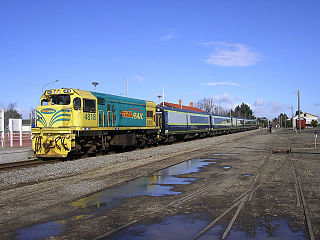
The Wairarapa Connection is a New Zealand interurban commuter rail service along the Wairarapa Line between Masterton, the largest town in the Wairarapa, and Wellington. It is operated by Wellington suburban operator Transdev under contract from the Greater Wellington Regional Council. It is a diesel-hauled carriage service, introduced by the New Zealand Railways Department in 1964 after passenger demand between Masterton to Wellington exceeded the capacity of the diesel railcars then used.
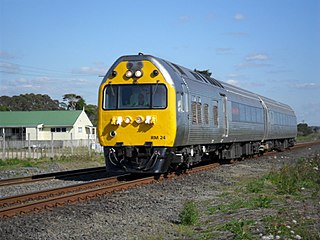
The RM class was the classification used by the New Zealand Railways Department (NZR) and its successors gave to most railcars and railbuses that have operated on New Zealand's national rail network. "RM" stands for Rail Motor which was the common name at the turn of the 20th century for what became known in New Zealand as railcars. As many types of railcars are operated, class names have been given to each railcar type to differentiate them from others.

The Napier Express was a passenger express train operated by the New Zealand Railways Department initially between Napier and Palmerston North and later between Napier and Wellington. It ran from 1891 until 1954.
The Wairarapa Mail was a passenger train operated by the New Zealand Railways Department (NZR) between Wellington and Woodville, continuing on to Palmerston North as a mixed train. It ran from 1909 until 1948 and its route included the famous and arduous Rimutaka Incline.
The Rimutaka Incline Railway Heritage Trust is a non-profit, charitable trust in New Zealand that was established in 2003 with the objective of reinstating an operating heritage railway over the Remutaka Ranges using the original route of the Wairarapa Line between Maymorn and Featherston, including the world-famous Rimutaka Incline.

Kaitoke railway station was a single-platform rural railway station on the Wairarapa Line between Upper Hutt and Featherston in the Wellington region of New Zealand's North Island. Initially it was the railhead of the Wairarapa Line, at a point where the railway met the main road between Upper Hutt and the Wairarapa. Later it was a point at which locomotives were changed, steam engines were watered, trains could cross, and passengers could make use of the refreshment room.
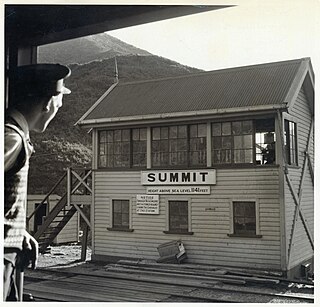
Summit railway station was at the summit of the Wairarapa Line over the Rimutaka Ranges in the Wellington region of New Zealand’s North Island and was where trains were marshalled for a descent down the Rimutaka Incline or for Fell locomotives to be extricated from a train that had ascended the Incline. The station was between Kaitoke and Cross Creek stations on the Wairarapa Line. The station was bypassed when the Rimutaka Tunnel was opened.
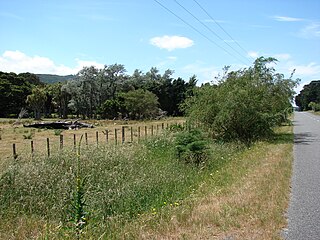
Pigeon Bush railway station was a single platform, rural railway station in an area of the South Wairarapa district known as Pigeon Bush, about 6 kilometres (3.7 mi) south-west of Featherston, in New Zealand's North Island. The station was between Featherston and Cross Creek stations on the Wairarapa Line. The station was bypassed when the Rimutaka Tunnel was opened.
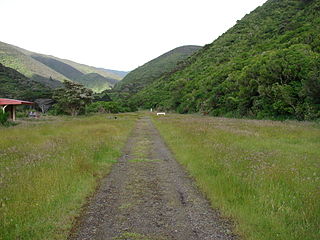
Cross Creek railway station was the base of operations for the Rimutaka Incline, a Fell railway over the Remutaka Ranges, and part of the original Wairarapa Line between Upper Hutt and Featherston in the Wellington region of New Zealand's North Island. The station was between Pigeon Bush and Summit stations on the Wairarapa Line. The station was bypassed when the Rimutaka Tunnel was opened.

The Remutaka Rail Trail is a walking and cycling track in the North Island of New Zealand. It runs between Maymorn and Cross Creek, and follows 22 kilometres (14 mi) of the original route of the Wairarapa Line over the Remutaka Range between the Mangaroa Valley and the Wairarapa, including the world-famous Rimutaka Incline. Parts of the trail are also used by vehicles both from the regional council and from forestry companies with tree plantations in the area; members of the public have limited vehicular access from the Kaitoke end to a car park, go-kart track and gun range. Access is also granted by permission to horse riders. Touring coaches have been used upon occasion to convey tourists and other visitors to various parts of the route.

Fernside railway station was a flag station that served the small rural community of Fernside, north-east of Featherston in New Zealand’s North Island. It was located on the Wairarapa Line near the southern bank of the Tauherenikau River. The station opened to traffic in 1880 and closed nearly a century later in 1975.
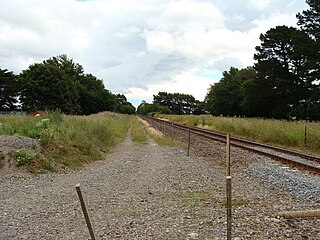
Clareville railway station was a flag station serving the small settlement of Clareville, north of Carterton in the Wairarapa region of New Zealand's North Island. It survived for nine decades from when it opened in 1880 until closure to all traffic in 1970.

Kopuaranga railway station was a flag station that served the small rural settlement of Kōpuaranga, 12½ km north of Masterton, in the Wairarapa region of New Zealand’s North Island. It was located on the Wairarapa Line between the stations of Opaki and Mauriceville. From its opening in 1886 it handled both passenger and freight traffic for 97 years until closure in 1983.
















